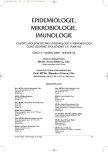Factors of Virulence and Mechanisms of Resistance to Aminoglycosides in Clinical Isolates of Enterococcus faecalis and Enterococcus faecium with High-level Gentamicin Resistance
Authors:
M. Filipová; H. Bujdáková
Authors‘ workplace:
Katedra mikrobiológie a virológie, Prírodovedecká fakulta Univerzity Komenského, Bratislava
Published in:
Epidemiol. Mikrobiol. Imunol. 54, 2005, č. 2, s. 65-74
Overview
Enterococcus faecalis and E. faecium are grampositive commensal bacteria that may become pathogenic under the selection pressure. In view of natural resistance and effective mechanisms of genetic transfer, the treatment of enterococcal diseases is rather complicated. Aminoglycosides are clinically relevant antimicrobials that are frequently prescribed in practice since having good pharmacokinetics and showing synergism with beta-lactam and glycopeptides. One of the major mechanisms involved in aminoglycoside resistance is inactivation of the antibiotic agent by aminoglycoside-modifying enzymes (AGMEs) differing in the capacity for inactivation of specific types of aminoglycosides. The factors of virulence are also involved in enterococcal pathogenicity but their role in the pathogenesis of infectious diseases remains unclear. Production of betahemolysin (Hly), gelatinase (Gel), and aggregation substance (AS), and synthesis of enterococcal surface protein (Esp) are among the most frequently studied potential virulence factors.
Key words:
Enterococcus faecalis – E. faecium – aminoglycosides – resistance – factors of virulence.
Labels
Hygiene and epidemiology Medical virology Clinical microbiologyArticle was published in
Epidemiology, Microbiology, Immunology

2005 Issue 2
Most read in this issue
- Factors of Virulence and Mechanisms of Resistance to Aminoglycosides in Clinical Isolates of Enterococcus faecalis and Enterococcus faecium with High-level Gentamicin Resistance
- Congenital Toxoplasmosis: Possibilities for Laboratory Diagnosis
- Immunological Monitoring of Sepsis Using Flow Cytometry – Quantitation of Monocyte HLA-DR Expression and Granulocyte CD64 Expression
- Microbicidal Efficacy of a New Foam Disinfectant
